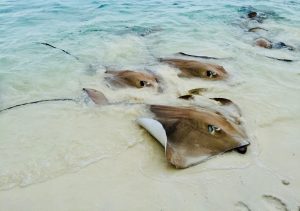Stingreys – deadly or delightful? These fascinating marine animals really can pack an electric punch – but there’s more to them than just a simple sting in the tail. Here are some fun facts about stingreys that might just help you in a quiz or two…
1. They have famous family members.
Stingreys are fish that belong to the phylum ‘Chordata’, of the order ‘Myliobatiformes’. They are relatives of sharks!
2. Skeletons without bones!
Stingreys do have skeletons but they don’t have bones! Instead, their skeletons are composed of cartilage. For this reason, they are known as cartilaginous creatures.
3. Fossil remains without bones…how can that be?
Strange though it sounds, fossilized evidence enables us to know that stingreys existed for approximately 150 million years! Their cartilage skeletons and teeth reveal their history.

4. There are scores of stingrey species.
The study of stingreys is widespread and has led to the current identification of at least a whopping 200 different species!
5. Where do stingreys live?
Stingreys can be found in both salt and freshwater. They are known to live in the oceans, as well as some lakes and rivers. They prefer the warmer waters of tropical and subtropical zones.
6. Life in the shallows.
Stingreys are more frequently found in shallow waters. This may be because they favour the warmer shallow water or because more people wade in the shallows. Stingreys lounge in the sand where they burrow and are easily camouflaged.
7. Stingreys don’t do well on eye tests!
Studies show that stingreys do not have great eyesight. They do however have extra sensory receptors which identify electrical emissions from their prey – located conveniently around their mouths!
8. Stingreys are uniquely shaped.
Stingreys have distinct shapes and features. Their mouths, gills, and nostrils are on their underside whilst their eyes are on top! We can understand how difficult it might be to see the food they wish to swallow!
9. Toothy terrors!
Stingreys have notoriously strong teeth. Their short flat teeth are strong enough to crack the shells on mussels and clams. Their toothy bands are hollow – so they’re lightweight and have multiple layers.

10. A mother’s love!
Apart from mating and sharing dining areas, stingrey moms often stay with their offspring for around three years. Groups of stingreys are known as ‘schools’.
11. Fishy ravioli?
Baby stingreys have been described as having the appearance of ravioli! They are born proportionally the same as their adult parents and instinctively swim immediately upon birth.
12. How many babies do stingreys have?
Stingreys usually give birth annually. They carry the eggs internally and eject between two to six fully formed babies. They are therefore known as ‘ovoviviparous’.

13. Stingreys have B.O.!
Yes, Stingreys can be stinky! The reason is they store urea in their skin which smells of ammonia.
14. Here’s why you should never tangle with a stingrey.
Stingreys have a ‘sting’ in their tails and it can be venomous. So much so, it has been used by humans as an anesthetic! Early records from Ancient Greeks show that the venom of stingreys was used by dentists centuries ago.
In Greek mythology, Odysseus, King of Ithaca, was killed by his son, Telgenus, who used a poisonous Stingrey spine as the tip of his spear.
15. A stingrey claimed the life of a modern legend.
Legendary zoologist and conservationist Steve Irwin – ‘The Crocodile Hunter’ – died in 2006 on September 4th as a result of a stingrey encounter. On this fateful day, Irwin was pierced through the heart by the stingrey, which struck him approximately 100 times – he was 44 years old.

FAQs about Stingreys
How long do stingreys live for?
In the wild, research has shown that stingreys live for between 15 to 25 years.
Do humans eat stingreys?
Yes, stingrey is on the menu in Singapore, Malaysia, and some other countries. It can be fried or boiled and tastes like scallops or sharks. Their flesh is 20% protein and is a rich source of vitamin B12 and vitamin D.
Are stingreys victims of cruelty?
Sadly, yes - in some cases, they are skinned alive by human hunters. Their skins are used for furniture and wall coverings. Thankfully, these horrific practices are becoming more and more known.
Do you know any fun facts about stingreys? Share them in the comments below!










